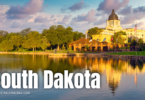Madison is the state capital of Wisconsin and the county seat of Dane County. Its population of about 260,000 people makes it the second-most populous city in Wisconsin, second only to Milwaukee. It is the eighty-first most populous city in the United States. Madison is the primary city of the Madison Metropolitan Area, which includes Dane County, Iowa, Columbia, and Green Counties. This metropolitan area has a population of about 655,000 people.
Madison is an important economic center for the state of Wisconsin. It has a technological sector that is thriving and healthy and is also the home to the headquarters of large companies like American Family Insurance, Epic Systems, Exact Sciences, American Girl, Promega, Sub-Zero, American Girl, and Land's End. The University Research Park is located there, and the city is replete with a plethora of biotech startups. In a 2018 survey, Madison was listed as the fourteenth out of the top fifteen cities in the world for obtaining venture capital startup businesses.
The area that would become Madison was inhabited by Native Americans before European explorers came. It may have been inhabited before that, but that is as far as the archaeological record has thus far been observed to go, as far as human habitation goes. When Europeans arrived, the Madison area was home to the Winnebago Native American tribe, also known as the Ho-Chunk people. They called the place where they lived Taychopera, which means “land of the four lakes.” These lakes are Mendota, Monona, Waubesa, and Kegonsa. There are effigy mounts in Madison that the Native American people constructed more than one thousand years ago for burial and ceremonial purposes. The mounds extend out from Madison to the lush prairie lands around the four lakes.
The European part of Madison's history began in 1829. This was when a former federal judge named Duane Doty bought more than one thousand acres of swampland and forest on the strip of land between Lake Mendota and Lake Monona. Doty intended to build a city there. His purchase of 1,261 acres for this purpose only cost him $1,500. The US government created the Wisconsin Territory in 1836, and a territorial legislature met in Belmont, Wisconsin. One of the tasks of this legislature was to select a permanent location for a territorial capital.
Duane Doty lobbied quite strongly for the capital to be Madison (as he owned it). The legislators were freezing at this winter meeting in a poorly heated, shabbily constructed building. Doty offered them buffalo robes to keep them warm and promised them the first choice of land lots in Madison if they chose it as the capital. He even promised to sell them the lots at discounted prices. Unsurprisingly, considering the savvy of his campaign, Doty's choice was selected, and Madison became the Wisconsin territorial capital.
The city was named by Doty. The name choice of Madison was after the fourth US President, James Madison, who had just died right before the territorial legislature convened. Doty named the streets of Madison after the thirty-nine men who signed the US Constitution. At the time the legislature selected Madison as the territorial capital, the city only existed on paper. Nothing had actually been built there. Doty planned for buildings, but at the time, it was just forest and fields. The legislatures were swayed not only because of Doty's generosity toward them in his lobbying, but because Madison was in a good location, being halfway between the new and not yet developed cities around Milwaukee in the east, and the important Prairie du Chien post in the west. It was also between lead mining towns in the southwest that were already highly populated, and the oldest town in Wisconsin, Green Bay in the northeast.
The cornerstone of the capitol building in Madison was laid in 1837. The legislature met there for the first time the next year. Two years after the cornerstone was laid, the plat of Madison was registered at the registrar's office of Dane County, of which Madison was at the time apart. Madison was officially incorporated as a village in 1846, at which time it had a population of 626. Wisconsin achieved statehood in 1848, and Madison kept its position as the capital of the new state. The next year, the University of Wisconsin was built there (the school is today known as the University of Wisconsin-Madison). The Milwaukee & Mississippi Railroad was built through Madison in 1856. Madison was incorporated as a city the same year the railroad was built there. It had a population of about 6,863 at the time it became a city.
The first capitol building was replaced with a new one in 1863, but that building burned down in 1904. The next capitol building that was constructed is the one that is there today, and it was built between 1906 and 1917.
Madison was the headquarters of the Union Army in Wisconsin during the Civil War. There was a tavern there that served as a last stop for the Union soldiers who were going west to fight on the frontier lines against the Confederacy. A training camp, called Camp Randall, was built on the west side of the city. Camp Randall not only served as a training camp for Union soldiers, but it was also used as a military hospital and as a prison camp for Confederate prisoners of war.
After the Civil War was done, Camp Randall became part of the University of Wisconsin. Camp Randall Stadium was built at the university in 1917. The former site of Camp Randall continued to be connected to the military by serving as a firing range for the university's ROTC members. This range was removed in 2004. The university today has no remaining connections to military training from the Civil War. The name of the stadium is the only vague reminder that the Union Army once trained there.




